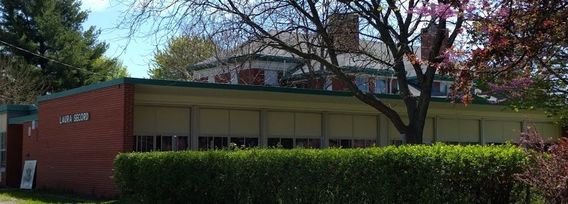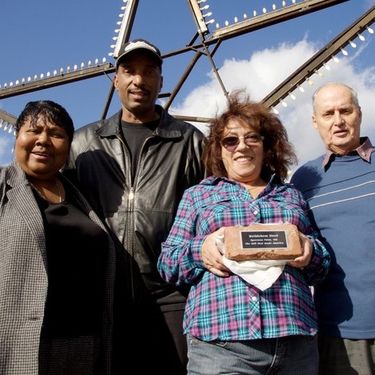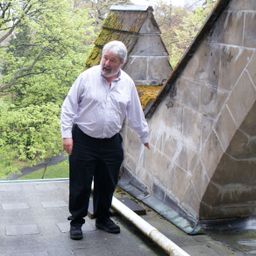
Candace Iron
Candace is currently a Partial-Load Professor of Liberal Studies at Humber College, Toronto, where she teaches courses in religious history and aesthetic theory. Additionally, Candace is the Vice-President of Membership of the Society for the Study of Architecture in Canada. Candace has presented more than 30 scholarly papers at national and international conferences and has published several chapters and articles dealing with church architecture in Canada, adaptive reuse, and architectural theory.
Refereed Contributions:
Chapters in books: Iron, Candace. "Adapting Pugin's True Principles to Canada: William Hay's Architectural Theory." Gothic Revival Worldwide: AWN Pugin's Global Influence. (2016) Leuven: KADOC (55-63).
Iron, Candace. "Religion to Religion: A Case Study for the Adaptive Reuse of Church Buildings by Non-Christian Religious Groups in Ontario, Canada." Le Devenir Des Églises: Patrimonialisation Ou Disparition. Ed. Jean-Sébastien Sauvé and Thomas Coomans. Québec: Presses De L'Université Du Québec, 2014. (93-113).
Refereed Contributions:
Articles in scholarly refereed journals: "Henry Langley's Catholic Church Commissions: adapting Charles Borromeo's Instructiones to the Gothic Revival in Canada." Journal of the Society for the Study of Architecture in Canada. 38.1 (2013): 47-58.
“Why Such an Odd Plan? Milton Earl Beebe’s St. Thomas Anglican Church, St. Catharines, Ontario.” Journal of the Society for the Study of Architecture in Canada. 31.2 (2006): 11-22.
“Thomas John Rutley: A Presbyterian Church Designer.” Journal of the Society for the Study of Architecture in Canada. 30.2 (2005): 39-46. Forthcoming Contributions (accepted):Iron, Candace. "Scott-to-Hay-to-Langley: The 19th-century Apprenticeship System and the Creation of a Gothic Revival Architectural Lineage in Canada." Medieval Gothic Architecture and Its Revivals. Ed. Candice Bogdanski and Malcolm Thurlby. Cambridge: Cambridge Scholars, forthcoming. (23 pages).
Non-Refereed Contributions (Articles co-authored with Malcolm Thurlby):
“Two Heritage Churches in Dundas, Part 2: Knox Presbyterian Church.” Raise the Hammer. (August 20, 2010).
“Two Heritage Churches in Dundas, Part 1: St Augustine's Roman Catholic Church.” Raise the Hammer. (July 30, 2010).
“John G. Howard's St James's Anglican Church, Dundas.” Raise the Hammer. (July 11, 2010).
“Gothic Traditions and Ontario Churches.” Heritage Matters Magazine. (September 2009): 22-23.
"St. John’s Anglican Church, Ancaster: An Architectural History." Raise the Hammer. (November 27, 2007).
Non-Refereed Contributions: Book Reviews
"A Review of Barry Magrill's, A Commerce of Taste: Church Architecture in Canada, 1867-1914." Letters in Canada 2012 83.2, n.pag.
Sessions in which Candace Iron participates
Tuesday 7 June, 2016
Wednesday 24 May, 2017
Friday 26 May, 2017
Wednesday 25 May, 2022
We propose a rich and colorful inaugural evening, in a mythical place: Dawson Hall, behind St James United Church (1887-1889, Alexander Francis Dunlop, arch.), known as the "Montreal Methodist Cathedral" - with 2000 seats, it was the largest Methodist church in Canada when it was built. Designated a National Historic Site of Canada in 1996, it escaped demolition in 1980 when it was classified as a historic monument, and then escaped extinction thanks to an ambitious restoration project, in...
Sessions in which Candace Iron attends
Monday 6 June, 2016
Private sector cultural heritage evaluation, protection, and management in Ontario exists at the nexus of academic theory, legislative direction, and land-use planning. Heritage work in this context follows a conservation approach to mitigate the loss of identified resources due to urban and infrastructure development. Ideally, the process balances ‘expert knowledge’ with regular and protracted engagement with government agencies, communities, and individuals to create evaluation criteria,...
Le patrimoine fait aujourd’hui l’objet d’attentions autant que d’agressions et de destructions. Cela peut s’expliquer par les difficultés de son identification ou de sa conservation. Cela peut plus profondément s’expliquer parce que, dès le départ, il célébre un événement ou conserve une mémoire qui peut être ou devenir une source de dissenssions et de conflits politiques. Enfin, sa reconnaissance suscite des gains économiques pour les uns mais des pertes pour les autres. Mais peut-être...
To celebrate our film series dedicated to heritage, sponsored by the Department of American Studies at the University of Maryland and the United States Chapter of the Association of Critical Heritage Studies, this event will spotlight the iconic Sugar Shack, which is rooted from Quebec to New-England and which is both the place of maple syrup production and of friendly gatherings during the maple syrup season. In a festive atmosphere, delegates will be invited to taste one of the essential of...
Directed by William Shewbridge and Michelle Stefano USA; 35 mins Presented by Michelle Stefano ___ After 125 years of operation, the Sparrows Point Steel Mill (Baltimore, Maryland) finally closed its doors in 2012. The film, “Mill Stories”, examines the importance of the mill from the perspectives of former workers and community members while connecting their story to the larger narrative of industrial boom and bust. The film seeks to amplify the voices of forme...
Directed by Christine Walley and Chris Boebel Presented by Michelle Stefano When the steel mills began closing on Chicago's Southeast Side, residents could feel the American Dream slipping away. Decades later, the loss of the steel industry has left permanent scars. The documentary film, Exit Zero: An Industrial Family Story, is named for the highway exit number for Chicago’s old steel mill neighbourhoods and captures the feeling of a region passed over. In poignant and some...
Tuesday 7 June, 2016
While historical churches are being abandoned all over the Christian West, more and more places are growing the opposite way: pilgrimage sites are being enlarged and enhanced, whole urban districts are being developed with churches and temples boasting diverse, and often unorthodox, religious practices. Epistemologically linked to heritage, the sacred now seems to follow a path of its own, staging itself in new settings where the “religious heritage” refers mostly to common practices, however...
The closing dinner of the conference, called “Pawâ” according to a French-Canadian tradition borrowed from the Native American lexicon, will be an opportunity to discover, in the heart of the Old Port of Montreal, an original culinary creation by the caterer Agnus Dei, from the renowned Maison Cartier-Besson in Montreal, leader in its field for its boundless creativity and event expertise. The dinner, in the form of stations, will offer delegates an exploration of Quebecois culinary heritage,...
Wednesday 8 June, 2016
More details to come. Bus tour. Tour Guide : Luc Noppen Coût / Fees : 48$ + taxes
Wednesday 24 May, 2017
Thursday 25 May, 2017
This lecture examines some of the many fine historical churches in the Niagara region from the 1830s to the early 20th century. We commence with St Andrew's Presbyterian Church, Niagara-on-the-Lake (1831) and explain Scottish, English and American associations for the 'temple-form' design. After brief consideration of St Vincent-de-Paul Roman Catholic Church, Niagara-on-the-Lake, attention is turned to the Methodist Church at Beaverdams and the reconstruction of its original 1830s design a...
Friday 26 May, 2017
The banquet includes a welcome drink, three-course dinner with three wine pairings, explained by a winemaker, as well as transportation to and from Ravine Estate Winery. Le banquet inclut un cocktail, un repas trois services avec trois mets-vins, expliqués par un vinificateur, ainsi qu'une navette aller-retour à Ravine Estate Winery. Cocktail : 18:20 Banquet : 19:00
Saturday 27 May, 2017
Architectural walking tour of Niagara-on-the-Lake with the Niagara Historical Society and Museum. Visite à pied de l'architecture de Niagara-on-the-Lake avec le Niagara Historical Society and Museum. Meeting Point | Point de Rencontre : Niagara Historical Soceity and Museum, 43 Castlereagh Street, Niagara-on-the-Lake. (Approx. 8 minutes walking from downtown | 8 minutes à pied du centre-ville) Guide : Glenn Smith Description :
Wednesday 25 May, 2022
We propose a rich and colorful inaugural evening, in a mythical place: Dawson Hall, behind St James United Church (1887-1889, Alexander Francis Dunlop, arch.), known as the "Montreal Methodist Cathedral" - with 2000 seats, it was the largest Methodist church in Canada when it was built. Designated a National Historic Site of Canada in 1996, it escaped demolition in 1980 when it was classified as a historic monument, and then escaped extinction thanks to an ambitious restoration project, in...
Thursday 26 May, 2022
Over the past twenty or so years, the architecture of churches in Quebec and across Canada has triggered new and increasingly pressing questions: how should we approach their conservation, use, or meaning in a context where religious practice is in sharp decline, where the economic situation of parishes is prompting hasty decisions, and where radical versions of secularism are being imposed in the public space? These new questions call for different ways of thinking about the historic valu...
Over the past twenty or so years, the architecture of churches in Quebec and across Canada has triggered new and increasingly pressing questions: how should we approach their conservation, use, or meaning in a context where religious practice is in sharp decline, where the economic situation of parishes is prompting hasty decisions, and where radical versions of secularism are being imposed in the public space? These new questions call for different ways of thinking about the historic valu...
Over the past twenty or so years, the architecture of churches in Quebec and across Canada has triggered new and increasingly pressing questions: how should we approach their conservation, use, or meaning in a context where religious practice is in sharp decline, where the economic situation of parishes is prompting hasty decisions, and where radical versions of secularism are being imposed in the public space? These new questions call for different ways of thinking about the historic valu...
Roger D'Astous is one of the most important Canadian architects of the 20th century. A student of Frank Lloyd Wright, he worked all his life to establish a northern architecture. This rebellious and flamboyant artist was a superstar of the sixties, then fell into disgrace before being reborn in the twilight of the century. Author of two Montreal icons, the Château Champlain Hotel and the Olympic Village for the 1976 Games, his residences are sensual works of art and his churches are strang...
Friday 27 May, 2022
Architectural history and heritage have historically been defined by superlatives. Vernacular traditions and local histories, on the other hand, have often been pushed to the margins or overlooked. These everyday spaces and places are often relegated to the quotidian, and perceived as unworthy of recognition. The COVID-19 pandemic, however, has changed our daily lives, and in many cases, our values. Now, we have been forced to see the everyday in a new light. What might this n...
Architectural history and heritage have historically been defined by superlatives. Vernacular traditions and local histories, on the other hand, have often been pushed to the margins or overlooked. These everyday spaces and places are often relegated to the quotidian, and perceived as unworthy of recognition. The COVID-19 pandemic, however, has changed our daily lives, and in many cases, our values. Now, we have been forced to see the everyday in a new light. What might this n...
Walking tour of the working-class housing and churches of Saint-Pierre-Apôtre and Sainte-Brigide-de-Kildare (now the Sainte-Brigide Cultural and Community Centre) in the south-central district of Montreal.The tour will be guided by Luc Noppen.A departure (by foot) will be organized from the conference site; the tour itself will begin at 5:00 pm at the Beaudry metro station (a metro station of Berri-UQAM, site of the conference).
Saturday 28 May, 2022
Queerness and lesbian, gay, bisexual, transgender, and queer histories are a part of architectural and historical production. Yet, these perspectives do not enjoy the same prominence as heterocentric narratives. This session aims to interrogate all aspects of gender and sexual identity related to the Canadian built environment. It seeks to scrutinize the successes and failures of architecture, architectural history, and heritage in accommodatin...
While the relationship between architecture and community are intrinsically intertwined, the built form of “community spaces” is not easily defined by any specific style, design, or building typology. Though there are many purpose-built community buildings across Canada, including community and recreation centres, performance venues, and town halls, many community spaces often evolve organically and informally from the community itself in a div...
Bus tour of the Soulanges Canal and its facilities (1899-1959), currently undergoing a major enhancement project. The first stop will be at the west entrance of the canal, the Coteau-Landing (Les Coteaux) entrance lock; from there, we will go to lock no. 4 and to the old Cedars hydroelectric power station (called "Petit Pouvoir"), classified as a historic monument since 1984 by the Quebec government, then to Pointe-des-Cascades where the spectacular locks no. 1, 2 and 3 are located. The vi...
We offer a unique experience for the closing dinner of this conference in Montreal, in the former U.S. pavilion of Expo'67 - the most popular of the exhibition, with 5.3 million visitors: the "geodesic dome" designed by architect Buckminster Fuller (1895-1983) with the collaboration of Shoji Sadao. The self-supporting steel honeycomb structure, covered with a polymer skin, was burned down in 1976 and redeveloped in the 1990s, according to the plans of architect Éric Gauthier, into an envir...













